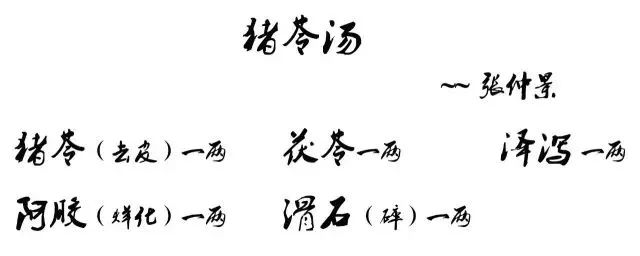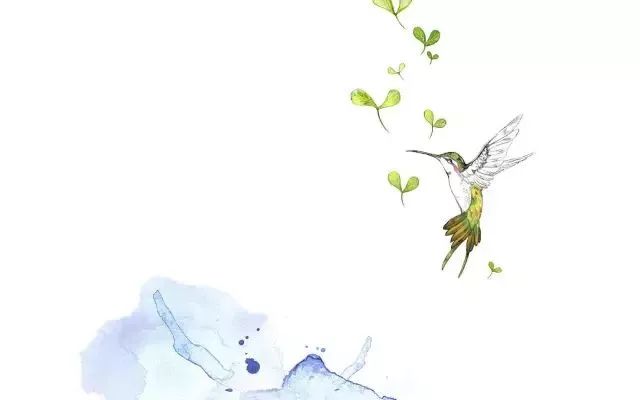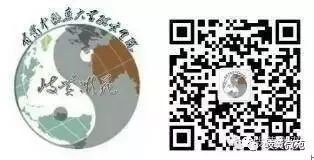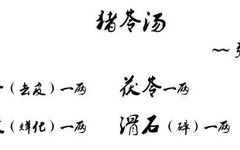If the pulse is floating, there is fever, thirst for water, and difficulty in urination, then the prescription is Zhu Ling Tang (Zhu Ling Decoction).

Combine the five ingredients with four liters of water, first boil four of the ingredients, take two liters, and strain; then dissolve A Jiao (Ejiao) in it. Take it warm, seven portions, three times a day.

Introduction: Scholars of febrile diseases throughout history have provided annotations on the “Treatise on Febrile Diseases”. Due to personal understanding limitations, there may be biases; readers should extract the essence and discard the dross, combining it with clinical practice and focusing on self-understanding. After all, to trust the book completely is worse than having no book at all! Comments are welcome at the end of the article for everyone to share their annotations and improve together!
Jin Dynasty, Cheng Wuji, “Annotations on the Treatise on Febrile Diseases”
This section discusses the guest heat residing in the lower jiao (lower abdomen). The pathogenic qi enters from the exterior to the interior, residing in the lower jiao, causing heat in all three jiao (upper, middle, and lower). A floating pulse and fever indicate heat in the upper jiao; thirst for water indicates heat in the middle jiao; difficult urination indicates that the pathogenic qi is obstructing the lower jiao, preventing the fluids from descending. Zhu Ling Tang promotes urination to drain the heat from the lower jiao.
Sweetness promotes diuresis, while blandness drains; the bland flavor promotes yang, Zhu Ling (Polyporus) and Fu Ling (Poria) are sweet and promote urination; the salty flavor drains yin, Ze Xie (Alisma) is salty and drains hidden water; smooth and slippery, A Jiao and Hua Shi (Talc) smooth the water pathways.
Qing Dynasty, Wu Qian, “Medical Canon of the Golden Mirror”
This section is related to Sections 221 and 222.
【Note】
This follows the previous section to clarify its treatment. The previous section primarily discusses exterior symptoms, cautioning against mistaken purging; this section confuses exterior and interior, with mixed pulse and symptoms, thus not only should purging be avoided, but sweating should also be avoided. If one mistakenly induces sweating with a floating and tight pulse, it will deplete fluids and harm yin. If one adds moxibustion, it will further assist the yang pathogen, leading to restlessness, anxiety, and insomnia. If purging is done with symptoms of abdominal fullness and aversion to heat, it will lead to emptiness in the stomach, with pathogenic heat disturbing the chest, causing heart discomfort, and a coating on the tongue, all of which are mistakes in purging; it is advisable to use Zhi Zi Chi Tang (Gardenia and Soybean Decoction) to clear and calm.
If the pulse is floating but not tight, and there are no feelings of discomfort, only fever and thirst for water, with a dry mouth and tongue, it indicates that the Tai Yang (Greater Yang) exterior pathogen has weakened, and the Yang Ming (Bright Yang) dryness and heat are severe; it is advisable to use Bai Hu Jia Ren Shen Tang (White Tiger Decoction with Ginseng) to nourish fluids and generate saliva.
If there is fever, thirst for water, and difficulty in urination, it indicates that the Yang Ming heat and drink are both excessive; Zhu Ling Tang should be used to promote urination and nourish dryness. However, in Yang Ming disease, the principle is to promote sweating; if there is excessive sweating leading to little urination and thirst, Zhu Ling Tang should not be used. This is because excessive sweating leads to dryness in the stomach, and without water, it cannot descend, resulting in little urination due to water depletion, not due to water retention. It is feared that Zhu Ling Tang will further promote urination, thus depleting fluids and exacerbating dryness.
【Note】
In Tai Yang disease, if there is restlessness, heat without sweating, and thirst, with difficulty in urination, it indicates Da Qing Long Tang (Major Blue Dragon Decoction); if there is difficulty in urination, it indicates Xiao Qing Long Tang (Minor Blue Dragon Decoction) minus Ban Xia (Pinellia) and adding Hua Fen (Pollen) and Fu Ling. In Tai Yang disease, if there is restlessness with sweating and thirst, with difficulty in urination, it indicates Gui Zhi He Bai Hu Tang (Cinnamon Twig Decoction combined with White Tiger Decoction); if there is difficulty in urination, it indicates Wu Ling San (Five Ingredient Powder). In Yang Ming disease, if there is restlessness without sweating and thirst, with difficulty in urination, it is advisable to use Ge Gen Tang (Kudzu Decoction) plus Shi Gao (Gypsum) as the main treatment; if there is difficulty in urination, it indicates Wu Ling San plus Shi Gao, Han Shui Shi (Cold Water Stone), and Hua Shi. In Yang Ming disease, if there is restlessness with sweating and thirst, with difficulty in urination, it is advisable to use Bai Hu Tang (White Tiger Decoction); if there is difficulty in urination, it indicates Zhu Ling Tang. In Shao Yang disease, if there is alternating chills and fever without sweating and thirst, with difficulty in urination, it should be treated with Xiao Chai Hu Tang (Minor Bupleurum Decoction) minus Ban Xia and adding Hua Fen; if there is difficulty in urination, it should be treated with Xiao Chai Hu Tang plus Fu Ling. In Tai Yin disease, there is no thirst. In Shao Yin disease with Yang pathogens, if there is restlessness, vomiting, red urine, and thirst, Zhu Ling Tang should be used; in Shao Yin disease with Yin pathogens leading to diarrhea, with white urine and thirst, Zhen Wu Tang (True Warrior Decoction) should be used. In Jue Yin disease with Yang pathogens leading to thirst, Bai Hu Jia Ren Shen Tang should be used; in Jue Yin disease with Yin pathogens transitioning to Yang Ming, if there is thirst, a small amount should be given to improve. Since the symptoms differ, the treatment methods also vary, and careful examination and clear differentiation are necessary.
【Collective Annotations】
Yu Chang states: The fever above is the same as the previous section, but with sweating, not aversion to cold, but aversion to heat, and heaviness in the body; all four are symptoms of Yang Ming, thus sweating, purging, and moxibustion should not be used. If there is a coating on the tongue, it indicates severe heat in the diaphragm, thus it is advisable to clear the heat with Zhi Zi Chi Tang, which treats the Tai Yang without harming the Yang Ming. If the previous symptoms worsen with dry mouth and tongue, Bai Hu Tang should be used to clear heat and generate fluids; if there is increased difficulty in urination, Zhu Ling Tang should be used to guide heat and nourish dryness. If there is excessive sweating and thirst, Zhu Ling Tang should not be used, as the heat pathogen enters the Yang Ming, which must first deplete its fluids; combined with excessive sweating, it further depletes fluids externally, leading to a risk of fluid loss, hence the caution.
Cheng Yingmao states: Heat in the upper jiao requires Zhi Zi Chi Tang; heat in the middle jiao requires Bai Hu Jia Ren Shen Tang; heat in the lower jiao requires Zhu Ling Tang.
Qing Dynasty, Ke Qin, “Collection of Treatise on Febrile Diseases”
The previous section discusses various symptoms, and this section again refers to the drinking of water. The repeated use of the character ‘five’ indicates the detailed explanation of Zhang Zhongjing’s treatment of diseases. Zhi Zi Chi Tang is not sufficient, Bai Hu Tang follows, and if Bai Hu Tang is insufficient, Zhu Ling Tang follows; these are the three methods to initiate treatment in Yang Ming. The reason is that the stomach is reluctant to lose fluids, neither allowing the stomach to dry out nor allowing water to stagnate in the stomach. Further meanings can be found in the Zhu Ling Tang symptoms.
Qing Dynasty, Huang Yuanyu, “Suspension of Febrile Diseases”
This section is related to Sections 221 and 222.
In Yang Ming disease, the pulse is floating and tight, with Tai Yang symptoms, dryness in the throat and tongue, with Shao Yang symptoms, abdominal fullness, with Tai Yin symptoms. Fever with sweating, not aversion to cold but aversion to heat, indicates that stomach heat is manifesting externally, but if there is Tai Yin abdominal fullness, then dampness is quite strong, leading to heaviness in the body.
Excess dampness with Yang deficiency, sweating, purging, and moxibustion are all inappropriate. If sweating is induced, Yang will be lost, leading to restlessness and confusion. If moxibustion is added, with sweating, Yang will be lost, leading to restlessness and insomnia. If purging is done, Yang will be lost, leading to a deficiency in the stomach, unable to defend against Yin pathogens, with pathogenic qi in the lower jiao, thus reversing the movement in the diaphragm, obstructing the Yang in the chest, causing heart discomfort, and leading to turbid stagnation. The heart is connected to the tongue, and turbid stagnation in the heart leads to a coating on the tongue; thus, Zhi Zi Chi Tang should be used to clear the turbid stagnation and relieve the heat.
If purging leads to Yin deficiency, with thirst for water, dry mouth, and tongue, Bai Hu Jia Ren Shen Tang should be used to clear the metal and drain heat, benefiting qi and generating fluids.
If purging leads to Yang failure and dampness, with a floating pulse, fever, thirst for water, and difficulty in urination, Zhu Ling Tang should be used, consisting of Er Ling (Polyporus), Hua Shi (Talc), and Ze Xie (Alisma), to promote urination and drain dampness, with A Jiao nourishing and clearing the wind. Dampness obstructs the Yang, leading to heat, hence the fever. The obstruction of wood qi leads to stagnation, thus causing difficulty in urination. The stagnation of wood qi leads to wind, damaging lung fluids, hence the thirst. The wind qi rises, hence the pulse is floating. In those with abdominal fullness and heaviness, purging will lead to Yang failure and increased dampness, thus presenting these symptoms.
Qing Dynasty, Cao Yingfu, “Subtle Observations on Febrile Diseases”
This section is the same as Section 222.
This follows the previous section on sweating, purging, and warming needles as a treatment for reversing the condition. The previous section discusses internal damp-heat, with floating Yang manifesting externally; if Yang does not manifest externally and fluids are damaged internally, then there will be thirst and dry mouth. If floating heat is on the surface, and water dampness is internal, then there will be thirst for water and difficulty in urination. These two symptoms are lighter than the previous ones. If fluids are damaged internally, the treatment should focus on clearing stomach heat and generating fluids, hence Bai Hu Jia Ren Shen Tang is appropriate, using Ren Shen (Ginseng) to retain dry qi in the qi aspect. If heat is floating externally and water is damp internally, then Zhu Ling Tang should be used to guide water pathogens and clear blood heat, hence using A Jiao to retain damp-heat in the nutrient aspect.
Liu Duozhou, “Lecture Notes on the Treatise on Febrile Diseases”
There are two interpretations regarding this section. One interpretation suggests that if Yang Ming heat affects the lower jiao, heat and water will accumulate, leading to difficulty in urination. The reasons for difficulty in urination can be Yang deficiency with cold or Yin deficiency with heat. Yang deficiency with cold requires warming herbs to warm and unblock, such as Wu Ling San (Five Ingredient Powder); Yin deficiency with heat requires Zhu Ling Tang, with a floating pulse and fever indicating the presence of heat. The other interpretation suggests that this section belongs to Bai Hu Tang syndrome, where excessive drinking leads to difficulty in urination, thus Zhu Ling Tang should be used to clear heat, nourish Yin, and promote urination. Yang Ming heat in the upper jiao uses Zhi Zi Chi Tang, while water stagnation in the lower jiao uses Zhu Ling Tang, and heat in the middle jiao uses Bai Hu Jia Ren Shen Tang.
Zhu Ling Tang consists of Fu Ling (Poria), Zhu Ling (Polyporus), A Jiao (Ejiao), Hua Shi (Talc), and Ze Xie (Alisma). Fu Ling and Zhu Ling are both diuretic herbs, with similar functions but different mechanisms. Fu Ling and Zhu Ling promote diuresis while also connecting the heart and kidney; Fu Ling calms the heart, while Zhu Ling enters the kidney, allowing the heart and kidney to interact; Ze Xie promotes diuresis while nourishing Yin, allowing Yin water to ascend. Hua Shi promotes diuresis while also lowering Yang qi, thus harmonizing Yin and Yang, while A Jiao is a blood tonic that nourishes Yin. Wu Ling San uses Fu Ling, Zhu Ling, and Ze Xie to promote urination, with Gui Zhi (Cinnamon Twig) promoting Yang and Bai Zhu (White Atractylodes) strengthening the spleen. Chen Xiuyuan summarizes Zhu Ling Tang as nourishing Yin, promoting urination, and clearing heat, while Zhen Wu Tang supports Yang, promotes water, and drives away cold. In Shao Yin disease with Yin deficiency and water, Zhu Ling Tang should be used; in Yang deficiency with cold and water, Zhen Wu Tang should be used. The kidney governs water in its Yin and Yang, with Shao Yin being the root of Yin and Yang, and the source of water and fire, thus there can be both Yang deficiency with water retention and Yin deficiency with water retention.
Zhu Ling Tang has broad clinical applications, such as in pyelonephritis where hematuria may occur. If there is a wiry and thin pulse, restlessness, insomnia, a red tongue with little coating, hematuria, and low back pain, this formula is very effective. It can be supplemented with two herbs: 20-30g of Han Lian Cao (Eclipta) and 1g of San Qi (Notoginseng) taken together, which shows significant efficacy. This formula can also treat renal tuberculosis and urinary tract infections in women, such as frequent urination, urgency, painful urination, and burning sensation during urination.
Hu Xishu, “Lectures on the Treatise on Febrile Diseases”
This section also has a preceding segment, “In Yang Ming disease, initially desiring food, but urination is not smooth, bowel movements are normal, the person has joint pain, appearing as if there is heat, suddenly sweating and resolving; this indicates that water cannot withstand the qi of grains, and with sweating, the pulse tightens and recovers.” This originally is a Tai Yang disease, with water stagnation internally, and the exterior not resolving, but they can eat, indicating strong stomach qi. Suddenly, sweating resolves the condition, thus strong stomach qi and abundant grain qi can also expel water. Later generations say that the stomach belongs to earth, and it can treat water; thus, it should not be purged. If purged, the stomach will be weakened and unable to treat water, right?
This section indicates that one should not use purgatives to produce changes in symptoms. It provides three examples: the first is restlessness; the second is damage to fluids, leading to dry mouth and thirst, which relates to Bai Hu Jia Ren Shen Tang, originally a Bai Hu Tang syndrome; the third is due to weakness of the stomach leading to difficulty in urination. Difficulty in urination indicates that internal water stagnation affects exterior heat and external heat, leading to a floating pulse and fever. Thus, with water stagnation, there is difficulty in urination, and this thirst is caused by difficulty in urination. Therefore, Zhu Ling Tang must be used to promote urination. However, Zhu Ling Tang differs from Wu Ling San in that the herbs are different; we can analyze this.
Wu Ling San treats qi rising, as it uses Gui Zhi, thus it has symptoms of dizziness and palpitations. This Wu Ling San syndrome has dizziness because the stomach has water stagnation, and excessive water in the stomach, along with Cang Zhu (Atractylodes), is more inclined to have exterior symptoms with difficulty in urination, while Zhu Ling Tang is not. Zhu Ling Tang consists of cold diuretic herbs, promoting urination while also clearing heat; it is not qi rising, as the water is not in the upper part, thus we use Zhu Ling Tang primarily when there is difficulty in urination due to inflammation in the lower abdomen and bladder, which is the best treatment, especially for urinary tract infections, using Zhu Ling Tang with Sheng Yi Ren (Job’s Tears). If the person has slightly dry stools, a small amount of Da Huang (Rhubarb) can be added, but not too much; now it is said to be 3g, as Da Huang is a strong purgative, but a small amount can help with the front yin without causing purging.
Generally, Zhu Ling Tang with Sheng Yi Ren is sufficient; Sheng Yi Ren should be used in larger amounts. Thus, Zhu Ling Tang treats conditions like gonorrhea and acute pyelonephritis effectively, but it should be modified by adding Yi Yi Ren (Job’s Tears) and Chi Xiao Dou (Adzuki Bean), as Yi Yi Ren is best for promoting urination, relieving heat, and quenching thirst. This diuretic that treats thirst must include Zhu Ling, as Zhu Ling has the effect of quenching thirst while promoting urination. Wu Ling San also contains Zhu Ling. Thus, it replaces Gui Zhi with Hua Shi, which is also a cold diuretic, and it does not use Cang Zhu, but adds A Jiao. A Jiao is a blood tonic that can stop bleeding. Thus, when heat damages the body, adding A Jiao is beneficial for Yin, hence it can be used when there is hematuria.
Zi Heng’s annotations
This section is the same as Section 222 and should closely follow Section 221 as one of the changes that occur after mistaken purging. If purging is mistakenly used, leading to a floating pulse, fever, thirst for water, and difficulty in urination, the main prescription is Zhu Ling Tang. After mistaken purging, the stomach qi is damaged, leading to internal water stagnation, hence the difficulty in urination; at the same time, Yang Ming pathogenic heat and mistaken purging will damage fluids, hence the thirst for water and accompanying fever. Yin is deficient while Yang qi does not consolidate, hence the floating pulse. The treatment should nourish Yin while clearing heat and promoting urination, which belongs to Zhu Ling Tang syndrome.
【Cross-reference】
Section 221: In Yang Ming disease, the pulse is floating and tight, with dryness in the throat and bitter mouth, abdominal fullness and shortness of breath, fever with sweating, not aversion to cold but aversion to heat, and heaviness in the body. If sweating is induced, it will lead to dryness, with restlessness and confusion. If moxibustion is added, it will certainly lead to restlessness and insomnia. If purging is done, it will lead to emptiness in the stomach, with pathogenic qi disturbing the diaphragm, causing heart discomfort, and a coating on the tongue; Zhi Zi Chi Tang should be used.


